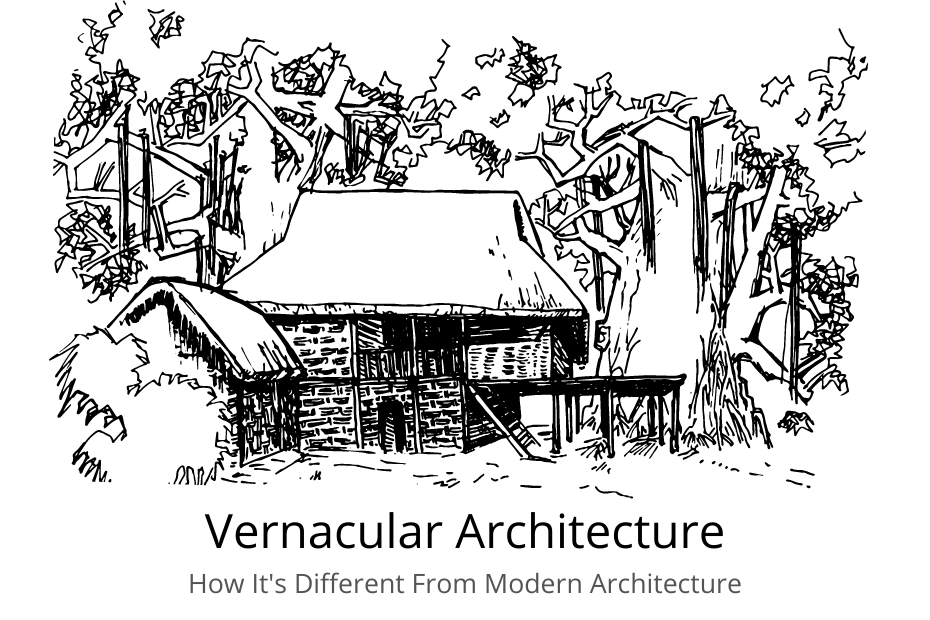Physical Address
304 North Cardinal St.
Dorchester Center, MA 02124
Physical Address
304 North Cardinal St.
Dorchester Center, MA 02124

Contents
If you’ve ever seen an Indonesian house or Mexican workshop, you’ve seen at least a reflection of the true meaning of a “vernacular” building. Beyond the prestige of modernism, there are certain underlying principles of construction that have maintained their relevance for thousands of years.
The body of a building, while not quite an artifact, has a distinct structure. Decks are often wide, trees may be used for posts, and there are areas where buildings are crafted out of clay. The finished product does not match the theoretical ideal of a structure made by machinery, and it does not come from experts in the newest technology. To understand this classification, take the most basic structure, the house.
While today it’s quite difficult to imagine any building type being created outside of a historical or modernist framework, the reality is that many of the world’s most valuable historic buildings were built outside of the highest level of design thought. Many of these structures are still visible today, and have been preserved through the process of creating new construction or maintaining the existing old structures. These include grand homes, palaces, and historical religious structures from a wide variety of areas, as well as smaller buildings used for everyday use. Most people are probably familiar with some of the most famous examples of pre-modern architecture, such as Istanbul’s Blue Mosque, the Kremlin in Russia, and the Sagrada Familia in Spain.
Modern architecture is a worldwide phenomenon of mass-produced and constructed buildings which use modern materials and technologies. A tendency for architecture to lose its connection to its site, taking the modern concept of universal scale and proportion as its starting point, with the result that common problems such as heat gain and solar orientation are overlooked, and informal measures are taken. But Modern architecture is actually a relatively new way of constructing buildings in architectural and urban terms. Architecture in the past has had a much different history than modern, with it being limited by very diverse building types.
As a counterpoint to the methods, forms and materials of modern architecture, traditional forms and materials have been used historically for their functionality and longevity. Historic modernist and minimalist design can be used to mimic traditional vernacular architecture but neglect the considerable time, experience and skill required to produce a traditional vernacular. Learning about vernacular architecture and seeing it for yourself, can give insight into the rich history of building techniques, providing a greater appreciation for the handcrafted techniques of modernist architecture. Some of them could be pocket friendly and good investment if used efficiently.
Vernacular architecture can be characterized as, essentially, ‘built in place’, without professional guidance, and in as many different ways as possible, it can be built with local materials and construction methods, it is constructed without advanced technology or attention to detail, and it does not adhere to existing zoning codes, and therefore often goes against current building codes.
In order to distinguish between this category and modern architecture, it is important to remember that different schools of thought exist. There are, of course, functional and stylistic differences between these buildings, some of which can be found at the classical Greek and Islamic schools, which largely focused on spatial form, detailed decoration, and overall architecture.
The term ‘vernacular architecture’ is used in several contexts, but typically it’s used to describe architecture used without any architect to dictate the built form. While it can be easier to describe the methods of construction used in pre-industrial societies than in the modern world, it is more difficult to give examples in this category. However, several examples of pre-industrial architecture exist throughout the world, some in very remote locations. The following examples of world-renowned ancient structures, that include a variety of styles, are considered ‘vernacular’, despite being built to strict architectural and/or historical requirements and specifications.
For each individual this is going to differ, but when it comes to the future of architecture it is important that every building movement has a voice, one that reflects the contemporary needs and concerns of society as a whole. Today architects have often had the sole responsibility of designing building, with a very small understanding of the socio-economic context of the place they’re designing. However, as architecture is a vehicle for the expression of our ideas, it can’t exist in a vacuum, taking little heed of the world around it. Vernacular architecture had to deal with limited materials and required little in the way of construction engineering.
Vernacular architecture provides a space for social activity, most commonly used as a place to live and for learning. Most often, the people who live in these structures don’t have the technology to fix or upgrade them, so they typically only use them to live. They seek to create something that is communal, comfortable, practical, and most of all, beautiful.
Some of these examples are more famous than others, but each have their own unique story and meaning. Some of the most beautiful examples of the ancient and traditional are still being created today. The pyramids, churches, and tombs all around the world were built in a time where nothing like them existed, with each group developing its own architectural style and unique methods of construction.
Originally built to last, many of the earliest primitive dwellings were made from unroofed log piles, crude adobe bricks, or even simply mud and sand. This type of construction was adopted by nomadic peoples in regions such as North America and Mesoamerica, where its durability, adaptability and resilience in the harsh conditions posed to such structures was invaluable. With many of the large majority of the earliest surviving native houses having been built around fire pits, it was also advantageous that these dwellings and structures were easily made safe for humans and their belongings in the event of fire.